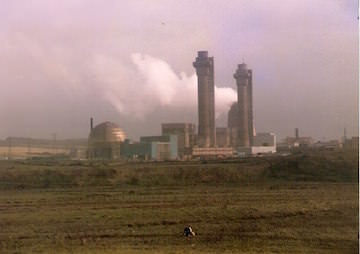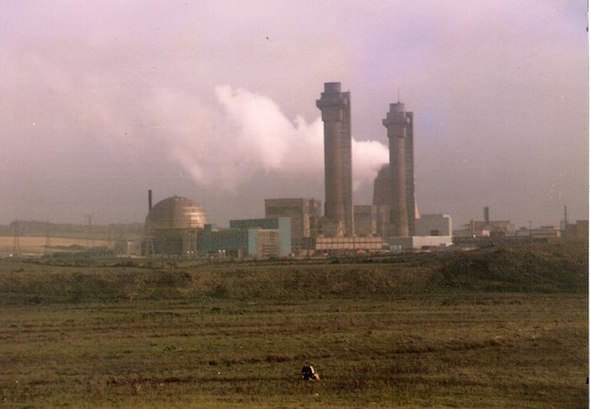Unhappy 21st Birthday for the U.K.’s Nuclear White Elephants
A state-of-the-art British plant intended to help cut greenhouse gas emissions by reusing spent nuclear fuel will close after years of what critics call “commercial and technical failure.”
By Paul Brown, Climate News Network

Storm clouds gather over Britain’s Sellafield plant, where reprocessing hopes have been dashed. (Chris Eaton via Wikimedia Commons)
This Creative Commons-licensed piece first appeared at Climate News Network.
LONDON — Re-using uranium and plutonium as fuel for nuclear reactors over and over again to make unlimited quantities of electricity was the nuclear industry’s ambition 25 years ago, and central to its claim to be the solution to climate change.
Once uranium has been mined, enriched and used as reactor fuel it need not be wasted, the industry has argued. After its removal from the reactor so little of the potential energy it contains has been harnessed that the fuel can be reprocessed and used again. It is dissolved in acid, the impurities are removed, its uranium and plutonium are extracted and it starts the cycle again as new fuel.
In the 1980s the industry insisted that investment in the giant reprocessing plants was vital because by the millennium there would be 4,000 nuclear reactors worldwide, with too little uranium to fuel them all. In fact, by the end of the century there were only 434 reactors globally, and much more uranium had been found.
Some governments, including those of the UK, France, Germany and the US, believed the industry’s sales pitch, even though environmental groups like Friends of the Earth and Greenpeace never accepted it. Critics said the cost of building the reprocessing plants was too high, and feared the consequences of producing vast stockpiles of uranium and plutonium which might never be used in reactors.
Public opposition was so great in Europe that some countries, notably Germany, abandoned the idea, but Britain went ahead. The British plant was at Sellafield in Cumbria, north-west England.
Proved right
Martin Forwood, from Cumbrians Opposed to a Radioactive Environment (CORE), said: “We never believed there would be a huge expansion in nuclear energy or that there was any need for reprocessing, We said the discharges of nuclear waste into the Irish Sea that it entailed could not be justified, and we have been proved right.”
Despite many objections the nuclear industry got the UK government to accept reprocessing as essential to ensure future expansion. This spring is the 21st anniversary of the official opening of the Thermal Oxide Reprocessing Plant (THORP) at Sellafield, designed to dissolve both British and foreign spent fuel and retrieve the plutonium and uranium.
It cost £2.85 billion (US$4.25 bn) to build and in its first 10 years it planned to reprocess 7,000 tonnes of spent fuel and make £500 million (US$745 m) profit.
Contracts had been signed in advance with Germany, Japan, Switzerland and other countries with nuclear power stations to reprocess their fuel in England.
But technical faults meant THORP failed to meet its targets, and after a decade only 5,045 tonnes had been reprocessed. The plant’s real profits or losses have never been disclosed.
Despite this doubtful beginning the British government sanctioned another enterprise, a brand new factory to turn the plutonium and uranium that had been produced into new fuel. The idea was to sell it back to the countries that originally owned it, closing the recycling loop.
Unworkable theories
New contracts were signed with Switzerland, Germany and Japan to produce 120 tonnes of MOX fuel (mixed oxides of plutonium and uranium) annually. But unfortunately the British nuclear industry could not translate its theories into practice.
The new plant did not work as planned, producing only 13 tonnes of fuel in ten years. Originally it was said to have cost £280m (US$415m). After Japan’s Fukushima accident it was decided to close the plant. The total loss to the British taxpayer for this failure was later admitted to be £2.2bn (US$3.3bn).
Despite the fact there was now no market or use for the plutonium and uranium it was producing from the spent fuel, the original THORP plant has continued to operate. It was periodically closed after a series of accidents and technical failures, and had been reduced to operating at half its original throughput, but was always given permission to restart, arguing that it still had foreign contracts to fulfill.
As a result Britain now has the world’s largest stockpile of used plutonium, about 100 tonnes of it British and 30 tonnes belonging to other governments. If it were all converted into nuclear weapons it would be enough to destroy all life on Earth.
There are also around 7,000 tonnes of uranium, for which there is currently no use and which must remain under armed guard night and day for fear of terrorist attack.
“Two white elephants don’t make for success at Sellafield.”
After years of indecision about how to deal with this unwanted surplus it has been announced that THORP should close in 2018 when all the foreign fuel has been reprocessed. Even after closure it will take years to decommission the plant and remove the waste, so not all of the 800 workers will lose their jobs at once and many will be re-deployed on other parts of the Cumbrian site.
Martin Forwood concludes: “That THORP should have failed so badly at so many levels comes as little surprise to those of us who warned — even before the plant opened — that the economics of the highly complex plant simply did not stack up and that worldwide demand for the uranium and plutonium that THORP would recover had already evaporated.
“Attempts to convert THORP’s plutonium into new fuel in an adjoining plant were equally disastrous…Two white elephants don’t make for success at Sellafield.”
The British government and the Nuclear Decommissioning Authority, which runs the plant on behalf of taxpayers, have never revealed the losses it has incurred. The government has no policy on what to do with the mountain of unwanted plutonium and uranium.
For accounting purposes, Forwood says, it is still counted as an asset, when in reality it is simply nuclear waste. The nuclear industry’s hopes of saving the planet from climate change by recycling reactor fuel have, he says, been “a complete commercial and technical failure.”
Your support matters…Independent journalism is under threat and overshadowed by heavily funded mainstream media.
You can help level the playing field. Become a member.
Your tax-deductible contribution keeps us digging beneath the headlines to give you thought-provoking, investigative reporting and analysis that unearths what's really happening- without compromise.
Give today to support our courageous, independent journalists.






You need to be a supporter to comment.
There are currently no responses to this article.
Be the first to respond.